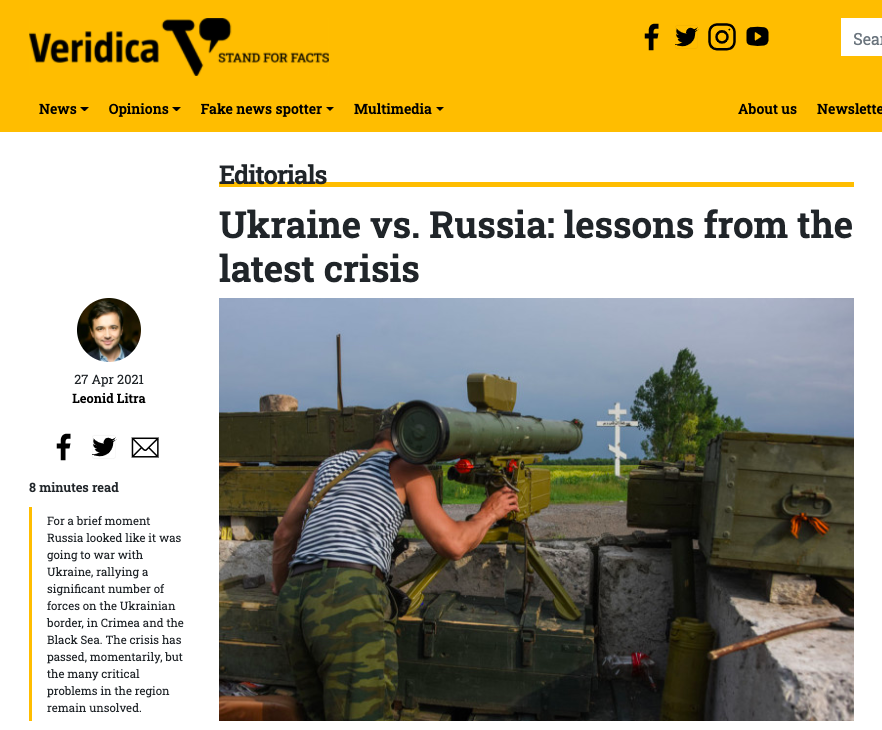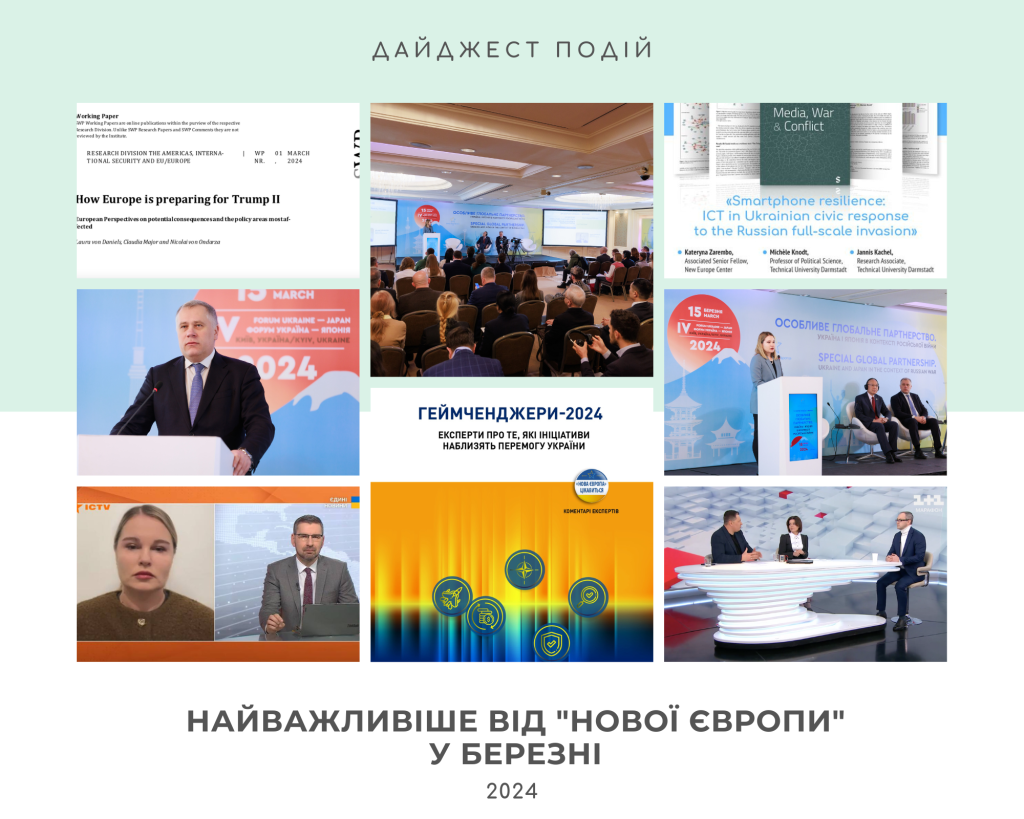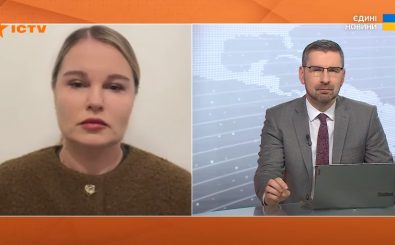Article by Leo Litra, New Europe Center Senior Research Fellow, for Romanian Veridica. The article is available in English and Romanian only.
For a brief moment Russia looked like it was going to war with Ukraine, rallying a significant number of forces on the Ukrainian border, in Crimea and the Black Sea. The crisis has passed, momentarily, but the many critical problems in the region remain unsolved.
Russia in the Black Sea region: background and reasons behind the recent military build-up
After seven years of Russian aggression in Ukraine, the West has yet to come up with a well-rounded and concerted strategy in order to provide a swift and clear response to the Kremlin threat. Although the big players capable of deterring Russia have reacted to the amassing of Russian troops on the Ukrainian border, their reactions did not hold up in Moscow most of the times. We’ve heard shy and unsophisticated statements which were too soft to send the Kremlin a hard warning. Russia needs to be sent clear and firm messages, as it will discard any message merely expressing “concern”. Russia, and most ex-Soviet countries for that matter, interpret soft messages as the reaction of weak and helpless actors. A joint resolution condemning the military escalation signed by the USA, the EU and the UK would have sent Russia a strong signal.
Another conclusion is that Russia’s influence in the Black Sea region has increased and will continue to do so over the coming years, making this region key to Russia’s show of force in the region. The militarization of Crimea after its annexation, the takeover of Azov Sea and the blocking of Ukrainian ports contrary to international regulations, the reinforcement of Russia’s fleet by transferring 15 battleships from the Caspian Sea to the Black Sea, setting up a Russian base in annexed Abkhazia in Georgia, all these moves have raised serious concerns in the Black Sea, not just for Ukraine, but for the whole region. Moreover, Russia has switched to a new kind of blackmail operations. Whereas so far it employed subversive actions such as cyber-attacks (Berlin, Paris), poisonings using chemical agents such as Novichok (Great Britain, Bulgaria), sabotaging munition depots (the Czech Republic, Ukraine), disinformation campaigns (virtually in all Western countries), right now Russia is using military force to make its stand. It’s a Machiavellian type of logic where the end justifies the means. Unfortunately, by threatening to go to war, Russia compels the West to give in.
The military build-up followed a number of changes in Russia, Ukraine and on the international scene. In Russia, Vladimir Putin’s approval rating stands at 65% (Levada Center). Although still significantly high, it is below the level the regime is accustomed to (the lowest level was hit in 2020 – 59%). Vladimir Putin’s popularity dropped especially among young people following the arrest of opposition leader Alexey Navalny. And the numbers keep dropping.
On the other side, president Zelensky’s approval rating is also lower compared to his first year in office. Zelensky made a few concessions to Russia in order to overcome the crisis more quickly, which lost him some support at home. To restore his reputation, the Ukrainian leader undertook a series of actions targeting Putin’s cronies in Ukraine. One of the most relevant cases was imposing sanctions against Viktor Medvedchuk (Putin’s henchman in Russia and a very influential Ukrainian politician) and his associates, including a ban on Russian propaganda in Ukrainian media – something which very much disgruntled the Kremlin.
Aside from that, perhaps the most prominent source of irritation for Russia is linked to Crimea’s water supplies. For decades the Peninsula had access to the fresh waters of the Dnieper via the artificial North Canal, which was dammed shortly after Russia annexed Crimea. The critical level of water supplies and the limited access to drinking water have put a large dent in Russia’s image as a “savior” of Crimea and a warrantor of her welfare. Patching up this problem without Ukraine’s help seems impossible right now. The topic is likely to strike a few chords in the future as well.
At international level, the change of administration in Washington could also be one of the reasons that pushed Russia into building up its military strength. By rallying its troops, the Kremlin raised the stakes in its dialogue with the Biden administration in order to test the US president’s commitment to supporting Ukraine. In fact, talks between Biden and Zelensky have intensified in the wake of Russia’s recent actions, and represent an important political signal for the Kremlin, much like the Biden-Putin dialogue. Kiev needs more signals of this kind, such as the recent visit of Poland’s Minister of Foreign Affairs, who expressed solidarity with and support for Ukraine. Similarly, Ukraine needs a bolder strategy than the one it used in 2014, one that focuses on lessons learned.
Russia and Ukraine, seven years since the conflict broke out
Russia didn’t just surround Ukraine, it managed to effectively take control of the Azov Sea, after it unilaterally closed the Strait of Kerch to Ukrainian and foreign maritime traffic by October, 2020, which is a clear violation of Ukraine’s sovereignty and international regulations in place. Ukrainian ports on the Azov Sea are now inaccessible, which translates into significant economic losses and a greater vulnerability towards Russia. The same happened with the airspace over Crimea and parts of the Black Sea, which was also closed down. Step by step, the largest part of Ukraine’s de jure maritime frontier is now under Russia’s control.
Unlike 2014, Russia has fortified its positions by reinforcing its military presence in Crimea, deploying more troops to Belarus for joint military exercises, and stationing troops in Transnistria illegally – all that in addition to the forces it has deployed on the Ukrainian border, stretching over 3,000 km on land and a few hundred km out at sea.
Although outnumbered and technologically outclassed, Ukraine is no longer the country it was in 2014. In the 7 years of conflict, Kiev has managed to reform its army and prepare for a Russian attack. All these years, tens of thousands of military have been training in war-like conditions, not to mention the Ukrainian forces who’ve actually seen war in the defense of Donbass.
Furthermore, during the recent crisis, in some regions groups of volunteers took up arms, much like in 2014 – the most recent example being the Ivano-Frankisvsk oblast. If war does break out, such groups will surface all over the country, including in occupied areas, which means we will witness a guerilla war, since Ukraine’s population is unwilling to give in to Russia.
On his end, president Zelensky has been making efforts to tone the situation down. First of all, he tried to mobilize the army in the event of a Russian attack. Zelensky went to Eastern Ukraine to show he is ready for any outcome, including the least desired one – a large-scale war with Russia.
At the same time, Zelensky met with Angela Merkel and Emmanuel Macron. He met with representatives of 6 of the 7 members of G7 inside of a week, with a view to rallying international support. All these actions show Zelensky and his entourage are truly concerned about the risk of a possible invasion.
Risks and possible solutions
The crisis has passed, but the likelihood of a war still lingers. Kiev and the West need to be ready for the worst-case scenario, although the probability of a large-scale war is rather low, for the time being. The recent show of force was rather an attempt at getting things rolling and making Ukraine more flexible. In the seven years of war, Russia has suffered great losses, including getting isolated from the West and missing important investment opportunities. The most serious consequence is that Russia lost Ukraine, and no amount of propaganda, overt or covert, will ever be able to win back the hearts and minds of Ukrainians. For this reason, Russia wants to solve the conflict in its favor and make a comeback on the international stage.
Another reason Russia went toe to toe with Ukraine could be linked to the recent relaunch of talks regarding the capturing and annexation of Crimea, against the backdrop of plans to create an international platform for the elaboration of a strategy on returning Crimea to Ukraine. The platform is due to be launched on August 23-24, 2021, marking 30 years of independence in Ukraine. From Moscow’s standpoint, it is downright arrogant to discard a resolution of the conflict in Eastern Ukraine and focus on Crimea – a taboo topic in Russia. This means Russia will have to “persuade” the leaders of other states who’ve already confirmed participation in the Crimea Platform to revisit their position and back off.
Right now, Kiev’s immediate concern is to focus on preventing a possible invasion by raising the stakes for Putin. The occupation of Crimea and parts of eastern Ukraine has taught this country to always think one step ahead of Russia – which is always easier said than done, but feasible nevertheless.
The United States’ position in this matter will be key to preventing a possible escalation. Washington has all the tools at its disposal to raise the stakes to such levels so as to make a new act of aggression a lose-lose scenario for Russia. Equally important will be the position of Germany and France, although Berlin seems to have lost some of its influence ahead of Angela Merkel’s imminent withdrawal.
In terms of security, a more robust military presence is needed in the Black Sea region. Patrols under the NATO flag (American, British or French) close to Odessa and along the Ukrainian coastline would be an effective deterrent. Any military assistance provided to Ukraine, apart from maritime support, should also focus on air defense, given the net superiority of the Russian air force.
Additionally, it would be extremely efficient if Ukraine were to ally itself with the United States. This would be much easier by supporting and facilitating Ukraine’s NATO accession, or by signing a consolidated security bilateral agreement with Ukraine. For years on end, Russia has employed the tactics of generating territorial conflicts to prevent NATO / EU enlargement to the east. Were he to be presented with clear evidence that this tactics isn’t working, Putin would lose an important incentive to continue the war against Ukraine, and the conflicts in Moldova and Georgia would be one step closer to a resolution. Finally, in terms of domestic reforms, Ukraine needs the support of the USA and the EU in order to implement a series of reforms that would allow it to become an important regional democratic center, and therefore a clear alternative to Putin’s autocracy. No other country in the world would have a bigger leverage for change in Russia than Ukraine. And a success for Ukraine is chance for Russian democracy.








